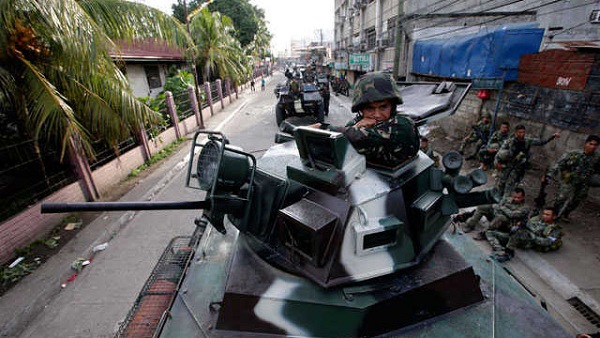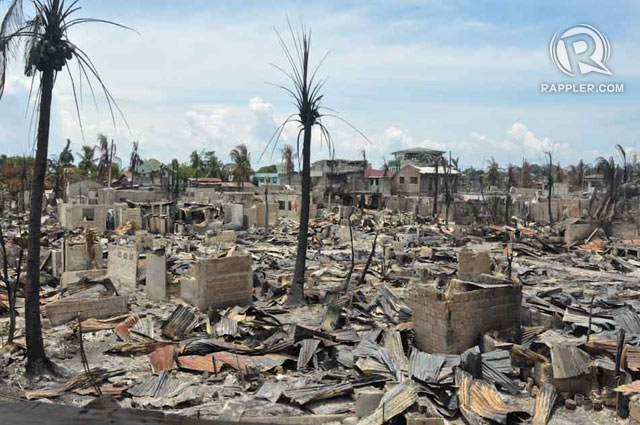SUMMARY
This is AI generated summarization, which may have errors. For context, always refer to the full article.
 It was 4 in the morning when the Vargas family was awoken by a loud thud.
It was 4 in the morning when the Vargas family was awoken by a loud thud.
This wasn’t the thud of a book falling on the floor or of a large fist pounding on a door. This thud was a thud that could only be described as a bomb, falling on their city, where their home, their life, and everyone they knew were still waiting for the sunrise.
Just seconds after the sound, shaking. Their house shook, their furniture shook, their faith shook. Luisa, the woman of the house, gathered her two children and prayed. When the house finally settled, what they heard next was what they thought would be the last sound they would hear at 4 in the morning on that fateful day: gunshots. Not one or two, but hundreds, like raindrops slowly falling on a windshield, getting louder and more frequent just like their prayers. And then, finally, silence.
I was born and raised in Zamboanga City. More than a “place of birth” in the dotted line, this was my home. I spent my days in school and after-hours running in the street with friends, our mothers secure in knowing we would come home by 6.
We said two prayers in school for flag ceremonies – one for Catholics and one for Muslims. Everyone bowed their heads in silence for both. Some kids wore rosaries around their neck. Some kids had amulets around their torso. Some girls wore hijabs. Sometimes yellow, sometimes pink, with rhinestones and embroidery.
Every day was a celebration of diversity and coexistence. You could pick out lunchtime chatter into equal parts of Tagalog, English, Visayan, Tausug and Chavacano. It was a period I saran wrap in my consciousness as some of the most carefree parts of my childhood. Zamboanga has not been the same way since.
Captive
I was 10 years old when the militants first took prisoner of my city in 2001 in Cabatangan, 6 kilometers from the city proper. We lived close to the military camp which, too, fell under the attack of the MNLF.
Like rain, the gunshots came, and slowly closed in. My only comfort lay in my mother, who held me and my sister in her arms in a small corner of the house, and who said, “Close your eyes…it will all be over soon. This will never happen again.”
I believed her. Her arms were a fortress. Her words formed a blanket. We stayed in that corner until the gunfire ceased and her words danced around in my head in pirouettes: “This will never happen again. This will never happen again.” It took 12 years for my mother, who is always right, to be proven wrong.

It was around 6 in the morning when Arnaldo,* a businessman, arrived in Zamboanga from Jolo, Sulu. The city was eerily quiet – unbecoming of a town that wakes up early. “Strange,” he thought, and he started his travel home on foot, as there were no tricycles nearby. In fact, no cars passed. No one else was in the street.
It began to trouble him until he saw two men walking towards his direction. “Daing hawnu kaw? (Where are you from?)” they asked. “Jolo,” he answered. And then they took him.
The two weeks went by fast. During the first few days in captivity, some of the hostages were tasked to cook for the rest. There was one instance when the rice was undercooked, and the rebels threatened to shoot the hostage in the head. Their guns eventually became the wooden stick by which the hostages complied. Do not follow, and you put your life in jeopardy. No cell phones, no sudden movements, no speaking with the other hostages in secret.
On one of the days, he recalled, MNLF leader Habier Malik himself visited the area where Arnaldo and the other captives were held. Malik turned to another captor and said to him in Tausug, “There are too many hostages, and they may be too hard to control. We should chop the heads of some of them.”
Thankfully enough, this did not have to happen. Every day, the hostages obeyed. In turn, the captors, who, from conversation, he found out hailed from Basilan, were “kind” to them. They were, like them, only following orders.
He escaped with two other men, one of them a pastor. When their captors were busy in the shoot-outs, they crawled as quietly and as swiftly as they could. Despite the fatigue, emotional stress and physical restrictions of age, they worked their way through the mud. They started at dawn. They jumped through fences.
It has been a month since they were found and the crisis ended. Arnaldo has left his job in Jolo and will relocate his family elsewhere, a place where he can come home to and rest worry-free at the end of the day.
The city his children grew up in, where he first established his name, his livelihood, is home no longer. While the spirit of the city remains, everything else has changed. For some people, however, the spirit of the city is enough to choose to stay.

A city, beloved
Dr. Santos* was working day in and day out at the height of the siege. He worked at the hospital where all the injured soldiers of the military were treated, and was thus heavily guarded. During one of his work days, a rebel wandered along the premises of the hospital. All of a sudden, gunfire. He allowed all the patients waiting in the lobby to hide in his clinic. When he felt the shots coming closer, he ordered everybody to duck until the last echoes of bullets cut through the halls.
This scenario was not foreign to him. He was tuned in to the news when the rebels first took hostages. His house also shook in 2001. Despite the kidnap warnings to him and his family, the bomb threats, the possibilities of another siege, he has chosen to stay. He always has.
“Ano pa bang magagawa mo eh mahal mo na?” (What else can you do? You have already fallen in love [with the city.])
As the rain and gunfire subsided, families went out of their homes to find refuge in each other. The land was silent, overwhelmed with peace. No traces of hatred or regret, not even anger – only the assurance that things can only get better.
As Zamboanga has proven to rise from the rubble of war, over and over, they are right. There is no spirit quite like a Zamboangueno’s. Like the hope and faith that were restored that day, the sun shone on their little city. – Rappler.com
*Names in the story have been changed to protect the identity of the individuals.
Elcee Vargas is a fresh graduate of Ateneo de Manila University. She has won several writing competitions for journalism and advertising. She grew up in Zamboanga City where she learned the true essence of coexistence. She has recently moved to Los Angeles where she lives independently, works, volunteers and talks to strangers.
Add a comment
How does this make you feel?
There are no comments yet. Add your comment to start the conversation.